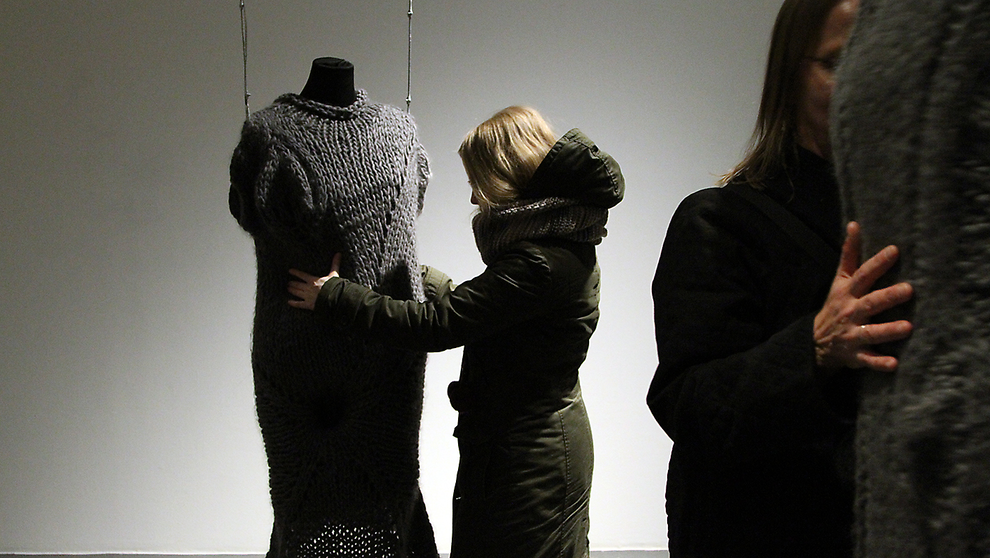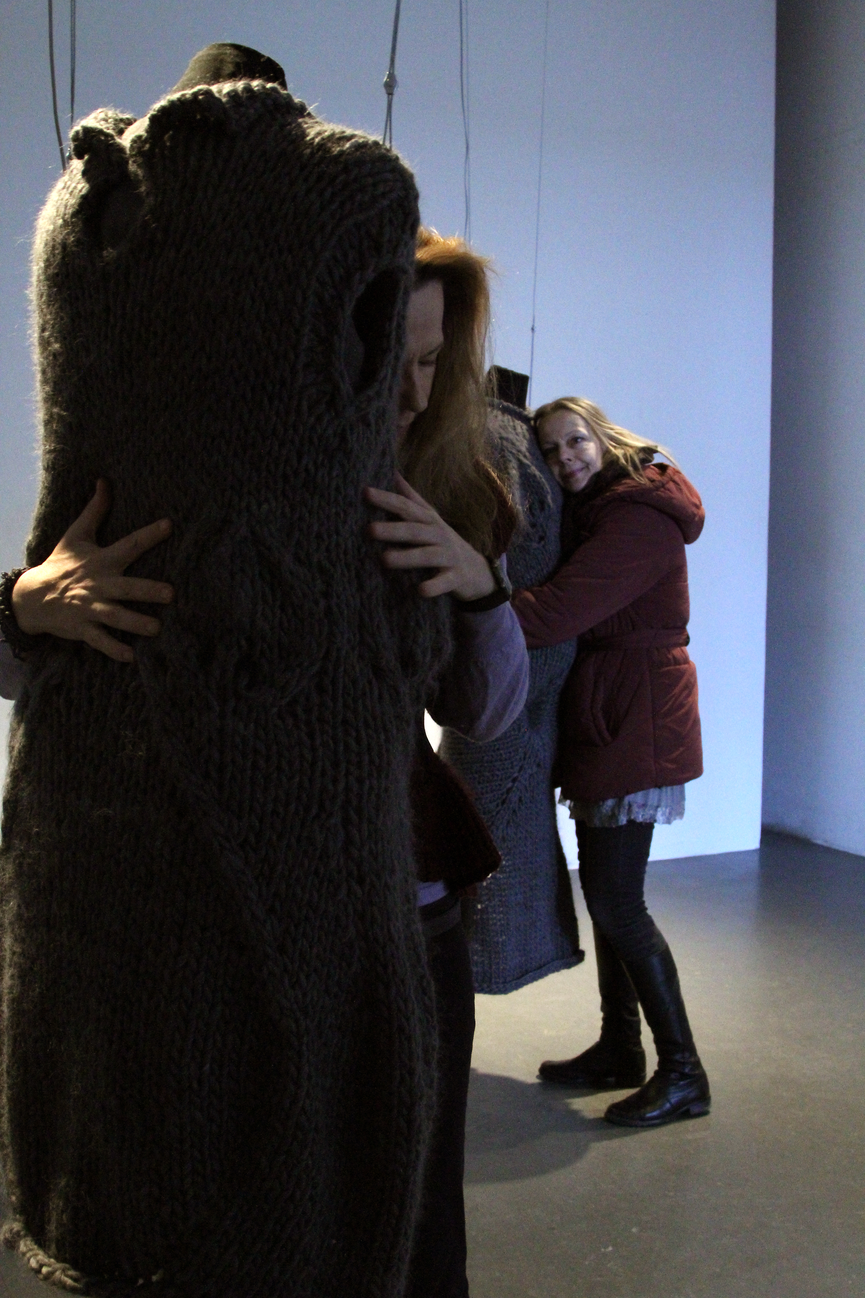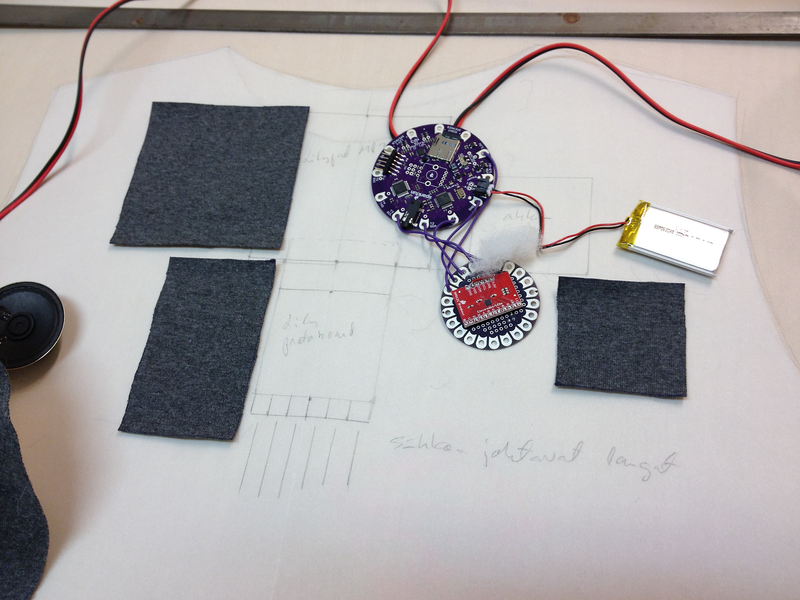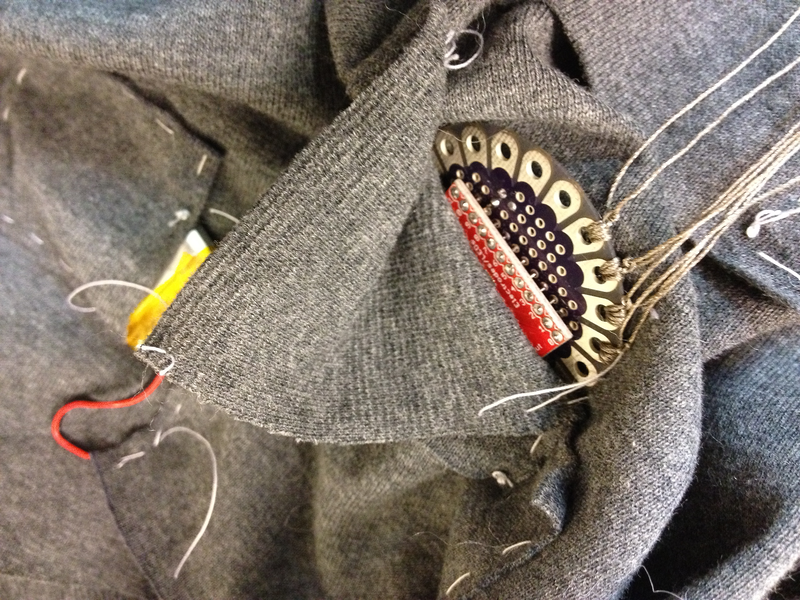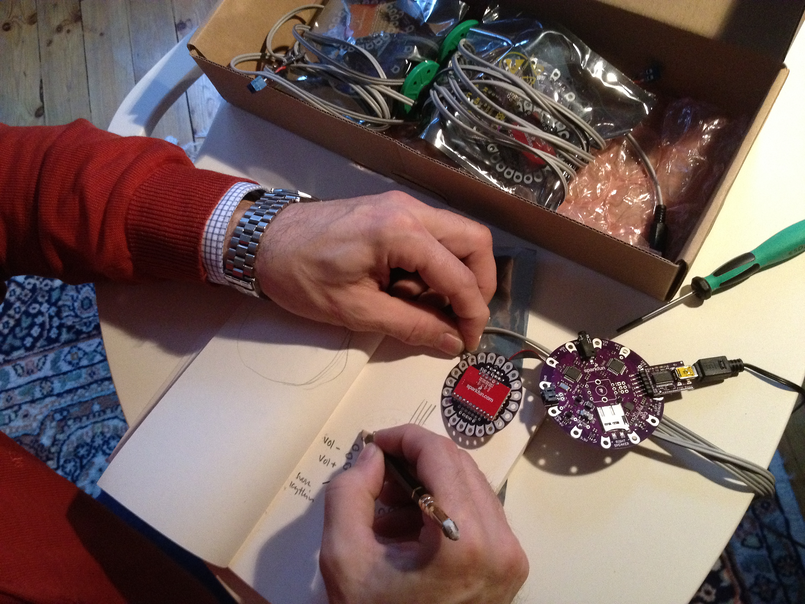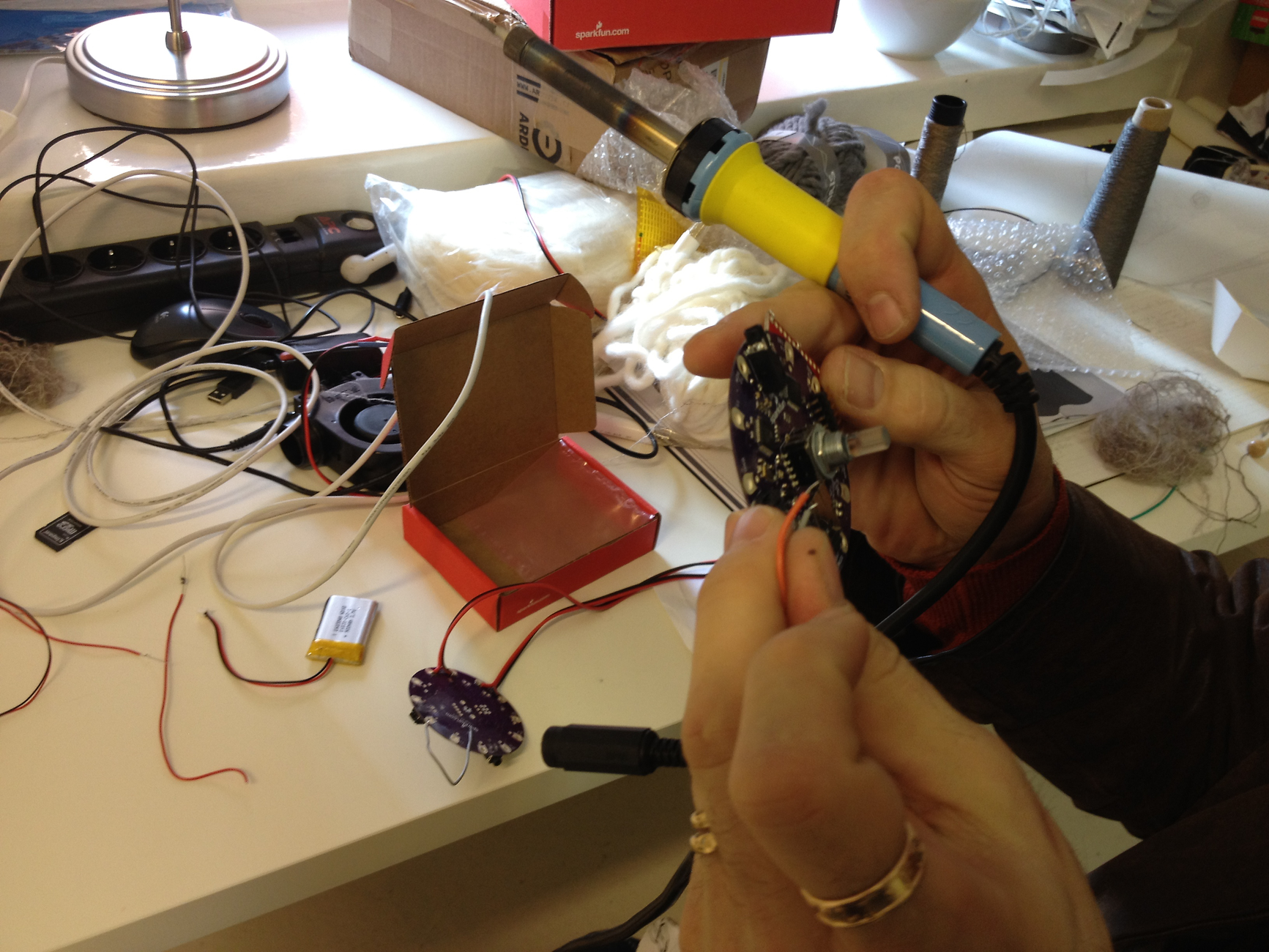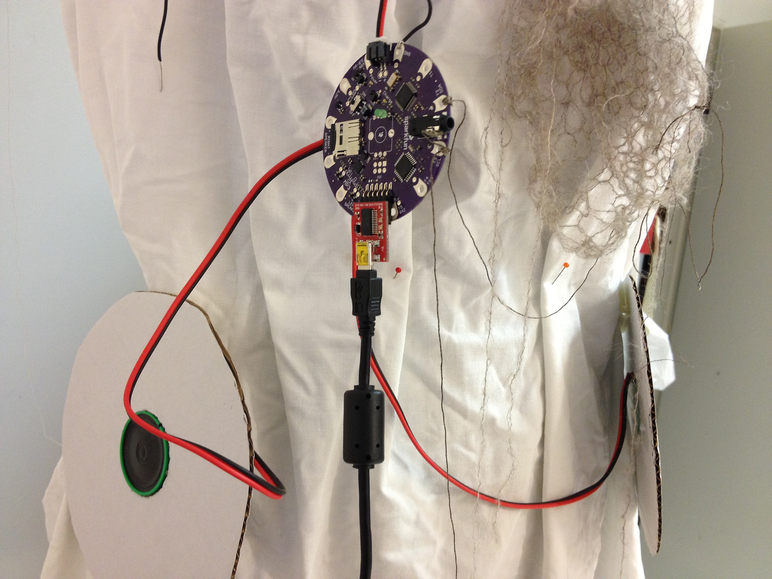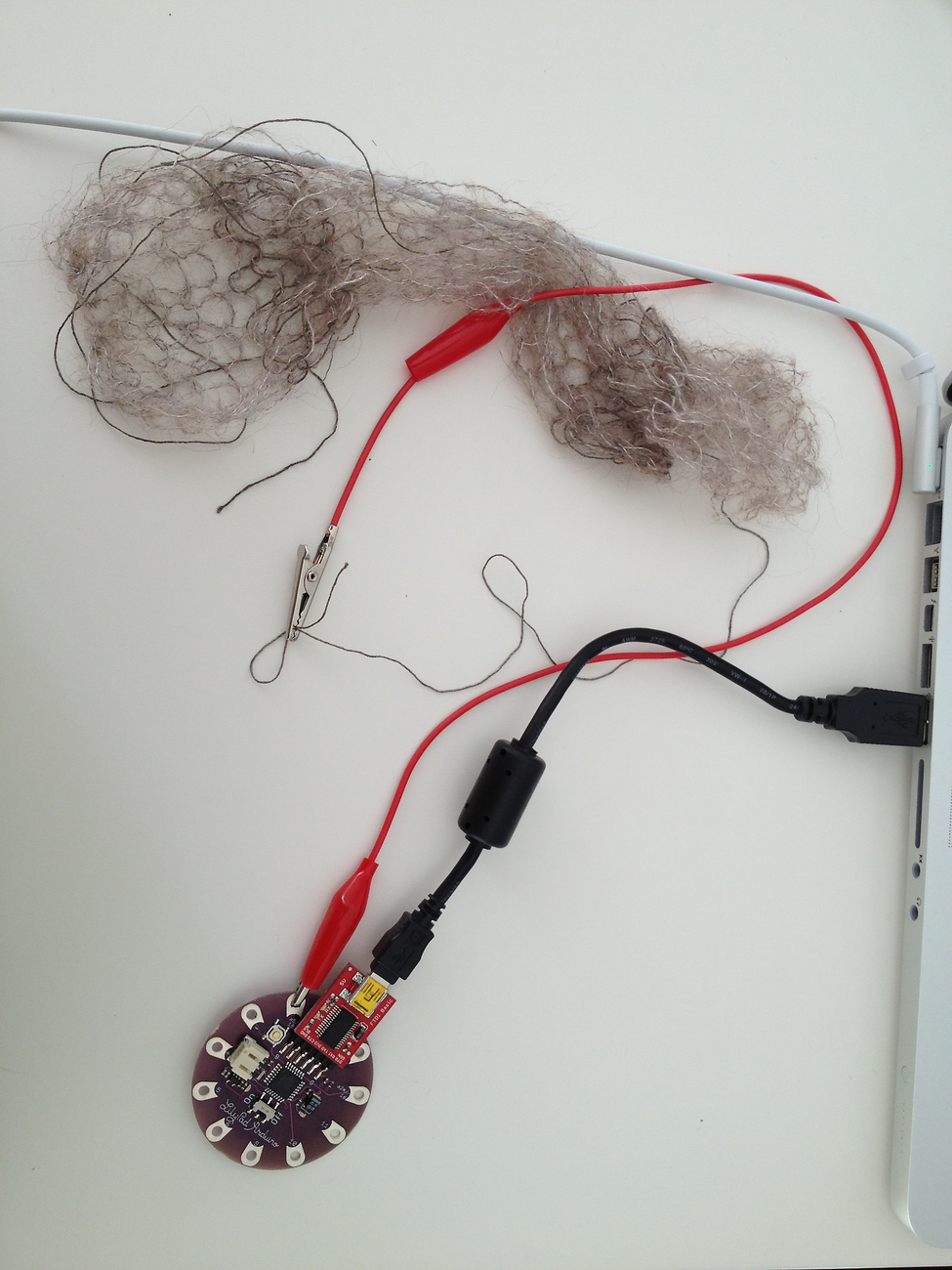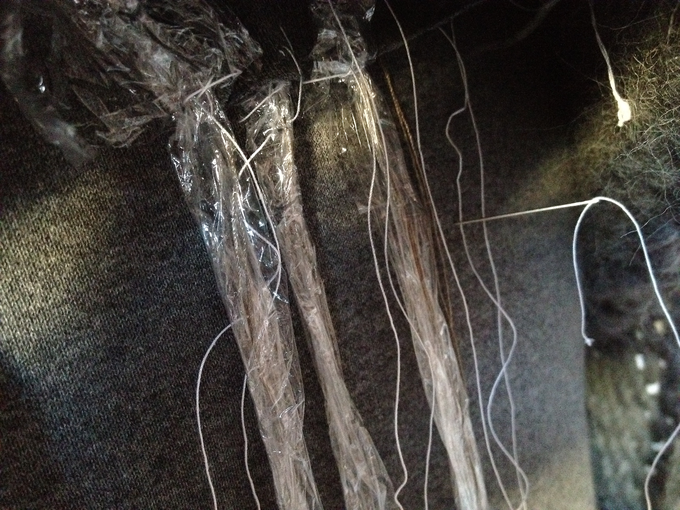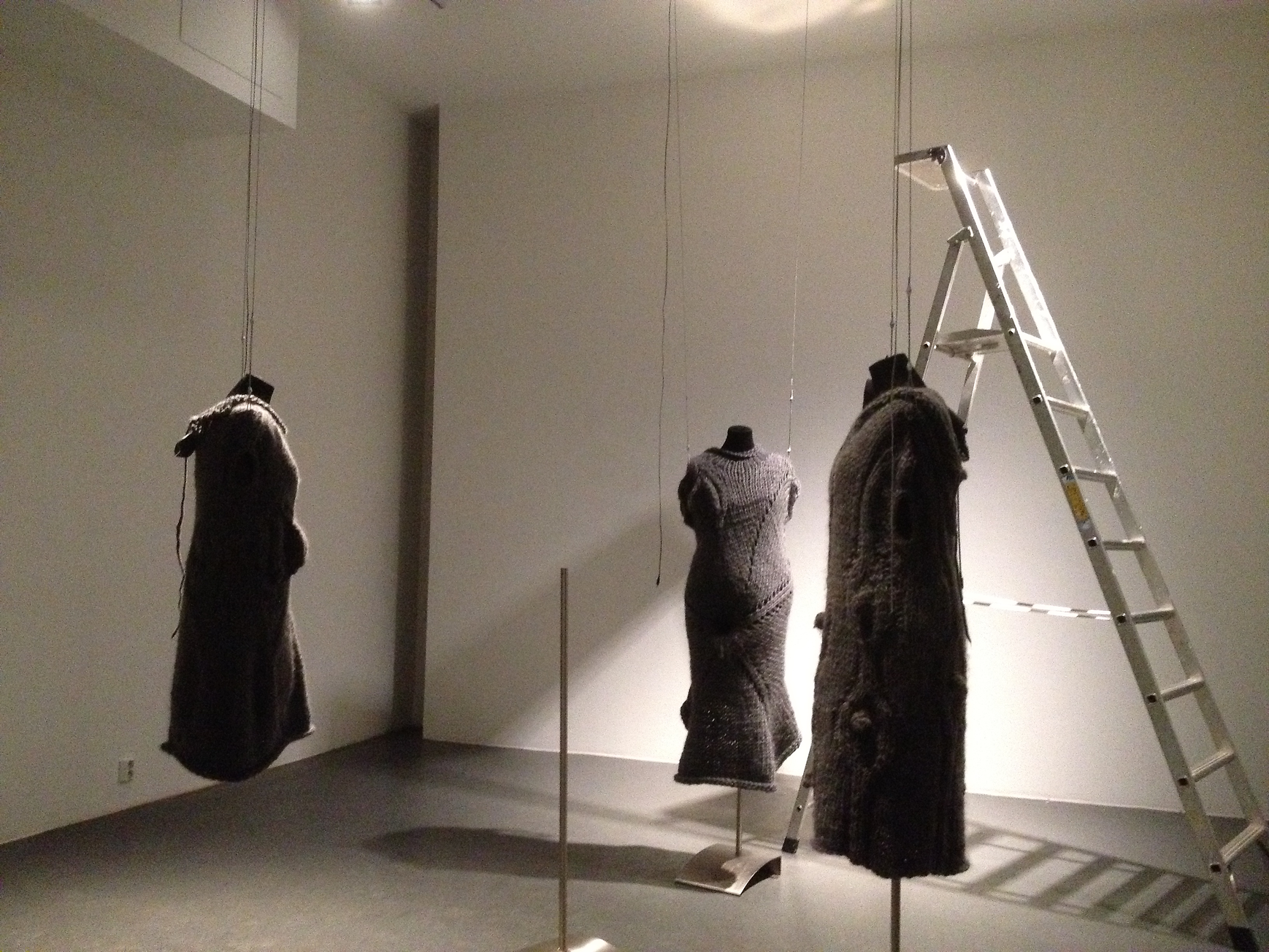"Untitled 1-3” are touchable objects that resemble disfigured human bodies, but they can also be seen as dresses or sacks hanging from ceiling. When touched they respond in ways that vaguely mimic human bodily actions. The “touchables” premiered at my solo exhibition in Galleria Sculptor, 2014.
To make a work of art available for touching in the context of a gallery is exceptional, though by no means unique. Over the last few decades, I have engaged in producing, (Tikka, 1999) works that challenge the privileged status of vision in the gallery space. “Untitled 1-3”, which interrogates touch, can be seen as part of this project. My idea is to frame the “Untitled 1-3” objects relationally, as entities that can be fully experienced in physical proximity only, and which actions of touching would gradually transform. Through my work I create new technical configurations for “touchability”: I ask and experiment with how touch as a sensory modality could be produced in different technical arrangements for interactive media.
“Untitled 1-3” should also be seen against the background of recent developments in new media, in which access to social interaction, entertainment and information is increasingly mediated by touch interfaces. Simultaneously, touch screens in our smart devices and in those urban screens that provide services and information have become an integral part of our daily experiential environments. These interfaces, in which touch interaction is mainly conceptualized as a series of specifically designed and adopted gestures for managing representational objects at the interface tend to narrow touch into an instrument for access. (Tikka et al. 2011)
With the “Untitled 1-3” I want to explore the possibility of thinking of touch in human-machine interaction in different terms. This involves a move away from conceiving touch as a mediating gesture, and towards conceptualizing it as a relational, performative event. Most of all touch is here examined as an embodied and technical phenomenon co-constituted in different mutual and highly specific material interactions.
In my artistic research in progress[1] I have inquired into human-machine interactions, and most particularly into their affective and embodied modalities. In this research, which draws on science and technology studies as well as on the recent discourses on materiality, the questions of how to think of interactivity, agency and different occurrence of materialization are central. The questions are addressed both in relation to the interfaces of my installations, that is, in relation to those events in which the installations are being co-performed with the audience, as well as in relation to the processes in which they are being produced. My most important intellectual source for considering human-machine interactions, interactivity and agency is Lucy Suchman’s work. Her performative understanding of agency resonates across a broad spectrum of scholarly work on science and technology studies. (Suchman, 2007). [2] In her reading of Karen Barad’s work she suggests that Barad’s agential realism can be linked with these other performative accounts of agency. (Suchman, 2007, 267-268) Suchman’s reading of Barad forms an important link between my ongoing artistic research and my exploration of Barad’s realist ontology.
Suchman argues that from a posthuman perspective, we need to consider critically the concept of nonhuman agency. She draws together several decades of debate on machine agency, while focusing on examining how boundaries between humans and machines are drawn, how these boundaries are grounded and what are their consequences. Her project can be seen as the investigation of the forms of agency that concern both humans and machines, as well as their entanglements as she questions “how capacities for action are figured at the human-machine interface and how they might be imaginatively and materially reconfigured”. (Suchman, 2007, 2)
Karen Barad defines her theoretical position, agential realism, as an epistemological-ontological-ethical framework for considering the human and the non-human, material and discursive, natural and cultural as enactments of boundary work, rather than as binary oppositions. (Barad, 2007, 26) Both Suchman and Barad share a posthumanist approach in the sense that they consecutively examine the question: how boundaries are enacted in practices. Posthumanism, for them, is a necessary approach for questioning how a human and her others are enacted in boundary making practices.
This question, shared by Barad and Suchman provides a starting point for my inquiry into Barad’s philosophy in conversation with my empirical work. The specific question, with which I approach Barad’s thinking is: how are bodily boundaries produced in embodied and affective modalities of interaction. This question delineates a path for first investigating Barad’s theorizing of phenomena as enactments of particular conceptual-material configurations. As part of this questioning we may need to call into question the status of the body as a dividing line between interiority and exteriority. (Barad, 2007, 136) Therefore it is necessary to explore the possibility of considering interactive phenomena at the interface of the “Untitled 1-3” as a series of boundary making configurations. In this context one should also ask, how are those particular modalities of human-machine interaction produced, which we may experience as “embodied”.
[1] Entanglements, Materializations - Embodiment, Technics, and Agency in Interactive Installations: The Networks of Production in New Media Art, PhD thesis, forthcoming, Department of Media, School of Arts, Design and Architecture, Aalto University
[2] In my readings of science and technology studies the theorization of agency in terms of performativity appears as a central theme. Consider, for instance the theorization of the mangle (Pickering, 1995), the emergent and performative understanding of actor-networks specifically discussed in reflections of the actor-network-theory (Latour,1999; Law,1992, 1999, 200; Callon, 1999) or the empirical-philosophical work on how realities are enacted by Mol (Mol, 2002; Mol&Law 2002) Suchman links Barad’s work to the work of Knorr-Cetina (1999) and Pickering (1984, 1995). (Suchman, 2007, 262) On the other hand, Barad herself criticizes Pickering for failing to account for the political aspect of performativity, and for attributing agency for individuals. (Barad, 2007, 411)
Interaction, intra-action and agency
In my projects I often imagine new articulations for liveliness by staging encounters in which human participants may have to negotiate their relation to computational entities, which seem to be partially alive. As such, my artistic practice has probed the boundary between human and non-human activity by investigating ways for experimentally reconfiguring relations between animate and inanimate in interactive events.
How to pursue a way of thinking of interaction, not as an event in which preformed and immutable entities engage in an interactive exchange, but as a relational event, in which the capacities for action emerge in the process of interaction? This question is crucial for a practitioner of interactive media, who imagines experimental dramaturgies at the interfaces of her installations. In this work I often have to think of ways in which the sense of liveliness, of meaningful exchange between two beings (a human and a computational one) expressing themselves in their particular ways could be staged with the means of specific arrangements of material interactions.
This artistic approach calls into question the conventional idea of interaction. As Lucy Suchman argues, it is important to rethink interactivity, not as the exchange between two pre-existent and bounded entities at the human-machine interface but as an event that takes its form in the interplay of human and nonhuman agencies, their social, material and technical configurations and the contingent actions associated to them. (Suchman, 2007, 263-267) Following Suchman’s argument, I understand interactions at the interfaces of my installations as performative events in which the entities interacting may be conceived as the effects of those relations, which are configured in the particular staging of those installations. Consequently then, in my practice, I conceptualize interaction at the human-machine interface as a performative event that takes place within the field of multiple and distributed agencies. These agencies must also be understood performatively: they are temporal and relational in the sense that they emerge in those interactions. Suchman, in her account addresses agency as capacity for action. In her words, agency in sociomaterial networks is not attributable to individual actors, but must be understood as “an effect of practices that are multiply distributed and contingently enacted”. (Suchman, 2007, 263-267)
In her agential realist account Karen Barad makes a conceptual distinction between interaction and intra-action. This distinction is crucial in Barad’s theoretical framework and she introduces it by distinguishing between interaction understood as event taking place between two fixed entities, in contrast to intra-action, which as an event is performative and emergent. In intra-actions the entities interacting should be understood as the effects of their relation. This distinction enables me to address the particular materializing events at the interfaces of the “Untitled 1-3” objects as intra-actions.
With the notion of intra-action Barad suggests that entangled agencies are mutually constituted in intra-active events. Intra-activity, then, for Barad, provides a critical counterpoint to the notion of interactivity, which presumes that there are separate and individual agencies, which exist prior to interaction. In an intra-active relation distinct agencies emerge through their intra-actions. But, as Barad points out, the agencies must be understood as distinct only relationally:
“agencies are only distinct in relation to their mutual entanglement; they don’t exist as individual elements” (Barad, 2007, 33, italics in the original)
Agential cuts and phenomena -
enacting touch
Barad’s major project involves a posthumanist rereading of the physicist Niels Bohr’s epistemological work in conversation with contemporary science studies, contemporary experimental physics and critical social sciences. The key premise of Bohr’s epistemo-ontological understanding, according to Barad, is that “we are part of that nature we seek to understand”.
Phenomena are generated within particular apparatus-specific arrangements, which provide the conditions of possibility for a referential relation between a concept and a phenomenon. (Barad, 2007, 121) Therefore, in Barad’s agential realism the primary entity of the realist ontology is not an independent object with “independently determinable boundaries and properties”, but phenomena. “The phenomena are the ontological inseparability of agentially intra-acting components.” The phenomena conceptualized in this way do not only suggest the epistemological intertwining of the observer and the observed, but in a more radical way the phenomena are understood as the “basic units of reality”. (Barad, 2007, 33)
A measurement always requires a particular apparatus. This apparatus provides conditions for meaning for a particular set of variables, while it excludes other variables. The boundary between what is measurable and what is not produces a cut, which is embodied in the apparatus. The cut frames the object from the agencies of observation. (Barad, 2007, 115) The cut into an object and the agencies of observation is always apparatus specific. An apparatus can therefore always be seen as a part of a phenomenon. Consequently then, for Barad apparatuses are not understood as passive instruments for observation, but as material arrangements that have agency, since the delineation of the object and the agencies for observation cannot be taken for granted. Apparatuses acquire their meaning through particular concepts that give their definition to the configuration of the apparatus, while they exclude other definitions. Apparatuses play a performative role, because physical phenomena with particular physical properties are produced through specific material arrangements. (Barad, 2007, 142)
Enacting “touch”
The particular phenomenon in which I am interested, in conversation with Barad’s philosophy and my installation the “Untitled 1-3”, is “touch”. This conversation takes as its starting point Barad’s conceptualization of phenomena as events that emerge through material intra-actions within specific conceptual-material arrangements. Consequently then, “touch” could be approached as the effect of those specific conceptual-material configurations, which figure as the interfaces of the “Untitled 1-3”. The question is, could these interfaces be understood as agential cuts that configure ontologies?
This preliminary understanding of touch as a phenomenon, emerging intra-actively by and within a particular conceptual-material arrangement, conceptualizes touch as an encounter or an event at the interface. This encounter involves both the embodied actions of a human participant and the conceptual-technical-material staging of those elements that constitute the installation as a material assemblage in an exhibition. In other words, “touch” is here approached as a human-machine encounter, but also as an event that involves various intra-actions across that imagined boundary.
“… It is through specific agential intra-actions that the boundaries and properties of the components of phenomena become determinate and that particular concepts… become meaningful. Intra-actions include the larger material arrangement… that effects an agential cut between the “subject” and “object” … “ (Barad, 2007, 139, italics mine)
In conversation with the “Untitled 1-3”, we must ask, through what kinds of intra-actions “the boundaries and the properties” of those elements by which “touch” is enacted become meaningful in the context of that particular installation. We must also ask, how the installation as a material arrangement could be conceptualized as an agential cut. In order to pursue these questions it is necessary to understand how touch is enacted at the interfaces of the “Untitled 1-3” series through specific material intra-actions – and more specifically, how “the embodied experience of touch” is enacted in these intra-actions.
Three cuts into the “Untitled 1-3”
As part of this questioning I propose three “cuts” into the materializing process of the “Untitled 1-3”. I understand these cuts as three particular but related enactments of it. The first cut enacts the installation as the object of discourse in this exposition and inquires into the conditions and the limits for making “Untitled 1-3” available as part of the exposition. The second cut enacts the installation as an experimental conceptual-material configuration, a particular kind of “touch” for a human-machine encounter and asks what it means to touch within this particular arrangement. The third cut foregrounds the collaborative work in which “Untitled 1-3” was produced.
Could these cuts be understood as agential cuts, as three very different configurations, each enacting the “Untitled 1-3” in their particular ways? Of these enactments the second cut focuses on the conceptualization and the technical configuration of an encounter between an embodied participant and the installation arrangement in an exhibition. It explores those intra-actions in which touch is enacted at the interface of the installation. The other two cuts, in a sense, frame this central cut. The first one reminds us, that to introduce and to represent the conceptual-material apparatus of “touch” in the second cut, one needs to launch a series of remediations, which are not transparent, but enact the “Untitled 1-3” in ways that are conditioned by specific media configurations and their entanglements. The third cut, on the other hand, investigates in more detail, how the apparatus for enacting touch – addressed by the second cut – was built in a collaborative process and explores how agencies shifted in this process.
"Untitled 1-3" installation
The installation “Untitled 1-3” consists of three dress-like objects, which are installed so that they hang from ceiling. The objects are hand knitted out of thick grey wool, and padded for shape. They are not intended for wearing, but for tactile encounters: touching, stroking, squeezing, pulling, caressing, and hugging. When touched they emit human-like sounds, sighs and burbs, or they respond by physical changes, vibrations, heat, or mechanical movement.
The dress-like artifacts, which constitute the installation “Untitled 1-3”, are not wearable. They are to be discovered in a gallery as if they were shells of another, absent body. Their shapes may, for some, resemble the deformed body shapes in Rei Kawakubo’s designs. Even though the dresses of the “Untitled 1-3” were not designed for the purposes of clothing, fashion as a system of references to embodiment, to the ways in which a human body is historically and culturally framed, aestheticized re- and de-formed, was an important starting point for my project. I have been particularly intrigued by the ways in which new technologies have been brought to bear on the fashion system as in the work of Iris van Herpen. She has used advanced techniques and materials, such as digital 3D printing tools for creating imaginative, gravity defying body shapes that often display exceptional beauty. Kawakubo’s deconstructions of the human and particularly of the female body, on the other hand, can be seen as deconstructions of the boundary making practices within the fashion system. Her works constitute referential networks, which interrogate, among other things, the body shapes and their capacities to make cultural distinctions. Moreover, the patterns and the materials that she chooses often aim at mobilizing particularly loaded cultural connotations. As I see it, her sculptural ways of thinking of the patterning of a garment pay attention to the intra-actions between a living, moving body and these conceptual and material dimensions of the fashion system.
Because of my past training as a textile designer I approach the dress-like forms of the “Untitled 1-3” objects through ways of experimental textile labour, looking for ways to create imaginative connections between “hard” electronics and “soft” knitting. Therefore my work can be related to the cultures of wearable electronics in its application of components commonly used in the field. However, there is an important sense in which my work deviates from the problem spaces of both fashion and wearable electronics. In “Untitled 1-3” the body inside an imaginary garment figures through absence. There is no anticipation of a moving body that would invest the garment with movement from within. There is no anticipation of a force from inside that would make a difference. The dresses of the “Untitled 1-3” are only interactive in their relation to another person, who approaches them from outside. For this reason it makes sense to address “Untitled 1-3” in this exposition as the site for tactile encounter.
I often call “Untitled 1-3” a responsive installation. I take this responsiveness to mean that the work establishes an event-space in which a person has to negotiate her relation to something, which appears to be in-between the states of the animate and the inanimate, and, renegotiate her relation to the tactile and the multimodal pleasures and anxieties emerging in the co-performances with these objects.
The conceptual starting point for the work is the figure of the maternal body as it may be perceived in a dream, in which one’s body is experienced simultaneously from inside and from outside. This experience might confuse the memory of one’s body as maternal body and as an infant body and would only remember the proximity in-between, forgetting its more specific visual form. The work in its current stage results in the shape of dresses that embody disfigurations and morphological displacements. The actual forms of the three dress-like objects emerged through experiments in associative knitting, as I, fascinated by the algorithmic logic of additions and subtractions discovered what kinds of three dimensional shapes came out of these experiments.
The installation still undergoes changes. As a responsive system, each of the dresses consists of a specifically designed architecture of electronic components, which can easily be reprogrammed while certain material elements in them can be modified too. Consequently then, each dress can be considered as an experimental site, open for continued creative labour.
First cut
“Untitled 1-3” premiered in Galleria Sculptor, Helsinki in January 2014. It was one of the three installations that together constituted the exhibition “Within Reach”. In that particular exhibition I was interested in working on two related themes: the configurations of touch and the conceptual-material understanding of the figure of a fold. In regard to the latter, I produced a series of figurations for structures – both conceptual and material – that have been turned inside-out.
Documenting “Untitled 1-3”
A documentation of an installation, while representing it, always frames it in a particular way. But how to represent an interactive event, and those embodied modalities of interaction that cannot be recorded with a camera? I used my old digital camera to record the installation both as a photographic and as a moving image documentation. The camera has the capacity to produce these recordings in certain spatial and temporal resolutions. But how does a camera recording enact the reality of an interactive installation? As an entangled, relational device it operates within a network of media configurations in which what is here presented as the document of the “Untitled 1-3” is enacted.
Could we then think of the documentation of the “Untitled 1-3” as an agential cut that enacts the installation in a particular way within and as part of an entanglement of relations? My artistic work has co-evolved with my camera, in a productive dialogue in which the boundaries of our mutually constituted capacities for action have been called forth in different recording situations. In this sense, the documents, the .jpg and .mov files that appear in this exposition, can be seen as intra-actions in which my operations with the camera, my bodily movements, the gestures of the persons interacting with the “Untitled 1-3”, the problems with the broken tripod, the intra-actions of the changing light conditions and camera settings, the daily rhythms of the gallery practices, the trams passing by and numerous other elements contributing to the production of the recordings, together enact the reality of the “Untitled 1-3” as a documentation.
The Research Catalogue as enactive space
What happens when I import these documentary files to the Research Catalogue publication platform? How is the “Untitled 1-3” enacted within this particular configuration?
From a media discursive point of view the Research Catalogue publication platform is an interactive hypermedia environment. As a hypermedia platform, it will remediate the documentation of the “Untitled 1-3” by exposing it to yet another framing operation in addition to the framing produced by the photographic apparatus: a series of hypermedia windows that the user may manipulate individually. (Bolter&Grusin, 2002). The access to the site and its different elements is mediated by the activity of pointing, which, as it is suggested by Lev Manovich (2002) as well as Bolter & Grusin (2001), instrumentalizes the relation between the user subject and the information object.
In this case the interactional logic of the hypermedia platform and the interactional logic of the “Untitled 1-3” are not congruous. If the objective of the “Untitled 1-3” is to re-think the subject-object relation in an interactive encounter, how to take into account those mediations, which impose their logic to the documentation of this gesture. Even though here is no solution to this discrepancy it must be acknowledged. I understand these hypermedia conventions as entangled practices, which are representational and historical, technical and sociomaterial practices. As such they participate in how the “Untitled 1-3” is enacted within the space of the exposition. They figure as conditions of possibility for producing this particular piece of artistic research.
My approach to the two dimensional layout of the publication treats it as if it was a timeline into which textual and visual “cuts” are inserted. The timeline organized by the visual and audiovisual material produces a retrospective view to the production of the installation. It begins with the documentation of the exhibition and moves backwards in time to the documentation of the research and development process. With this layout plan the concept of a cut assumes a double meaning. Each of the textual and the visual cuts figure as an agential cut into the reality of the “Untitled 1-3”. Yet, when placed into the timeline, they enact a montage of that reality, and may also enact some of the discontinuities in it .
Second cut
The interactive encounter between a human participant and “Untitled 1-3” consists of different actions and sensory modalities such as stroking, tugging, hugging, feeling, watching and listening. The actions and the sensory experiences associated with them involve different kinds of material contacts with the installation. In the process in which the installation was conceptually developed, the question how to choreograph the relations between actions, materials and anticipated sensations was of key importance. In this process “touch” became the most important concept for informing the production of different choreographed materialities. Therefore, it is possible to think of the “Untitled 1-3” as the enactment of a particular kind of touch. Touch in this context can be understood as a series of choreographed material intra-actions – or intra-active engagements – with the installation.
From the point of view of media design, the conceptual and the technical production of these intra-actions can be conceived as the experimental development of a human-machine interface. “Touch”, here, could be addressed as an agential cut that both delineates and binds together the intra-active engagements at the interface. Following Lucy Suchman’s reading of Barad, the interface can be understood as the site of distributed and entangled agencies emerging in what Suchman calls sociomaterial, technical and semiotic intra-active events. These intra-actions have the capacity to delineate both us and those artifacts which call us for interaction. In her words:
“…”the interface” becomes the name for a category of contingently enacted cuts occurring always within sociomaterial practices, that effect “person” and “machines” as distinct entities, and that in turn enable particular forms of subject-object intra-actions. At the same time, the singularity of “the interface” explodes into a multiplicity of more and less closely aligned, dynamically configured moments of encounter within sociomaterial configurations, objectified as persons and machines.” (Suchman, 2007, 268 italics mine)
My work for conceptualizing touch at the interface of the “Untitled 1-3” does not say anything about touch in any universal sense. As Barad points out in her elaboration of the notion agential cut, the concepts that are part of a particular conceptual-material arrangement are always relational. They are attached to those particular technical and material configurations from which they acquire their meaning.
Of the choreographies of the material engagements in “Untitled 1-3” it is possible to disentangle three particular threads and to explore how touch was enacted by and within those intra-actions.
Touching wool
It was important to find a material that would provide tactile pleasure and would be thick enough for rendering three-dimensional shapes. The yarn chosen is a double ply, natural grey wool produced in Norway. This kind of loosely spun wool also has the capacity to become felted. In other words, the type of yarn applied for the “Untitled 1-3” exposes the knitted elements to the continuous process of visible and tactile change in those areas in which they are being stroked and tugged for longer periods of time. Moreover, as natural, untreated fibre, which has retained its lanolin, the wool repels dirt and bacteria.
Wool is an animal fibre, originating from sheep. In Scandinavia, the type of wool that was chosen for the “Untitled 1-3” is often associated with outdoor life, and has been used in the past, for instance, in traditional knitted pullovers and mittens. Such a material may evoke memories of the past, if the sour smell of untreated, natural wool becomes associated with the memories of wet mittens and the softness of animal fur.
What kinds of differentiations are being enacted in association with these tactile, cutaneous and olfactory sensations? In the process in which a participant-object encounter is enacted, a series of differentiations takes place: between self and other, between human and nonhuman, between living and nonliving. Might it be possible that the animal fibre disturbs this series of differentiations by introducing into the domain of tactile sensations an association with nonhuman living animal. In other words, is it possible that animal fibre, in intra-active contact with human skin invests the installation with vitality that we usually associate with animal life?
Aural and tactile intra-actions
The “Untitled 1-3” objects respond to human touch in different ways, which are computationally scripted. Their output consisted of sonic and tactile responses. Each of the dress-like objects reacted in ways that were related to its morphology. The individual little protruding forms of a dress vibrated each in different rhythmic patterns when being touched. The one with a deep hole warmed up and emitted wet and burping sounds when a participant placed his or her hand into the depths of the pocket. In another, the sounds of human breathing were interlinked with the mechanical action in which the dress gradually began to rhythmically fill its pockets as if gasping for air.
Technically speaking, the surface of each dress can be seen as a touch interface, because the woollen surface, embellished with conductive yarn is able to sense touch, while the knitted forms generate vibrations, sounds and other events in response to touch. In these interactive feedback-loops touch becomes perceivable as an exchange between two entities, a human and a non-human, assuming the status of an encounter. These encounters, conditioned by intra-active material transformations, such as voltage readings translated into digital values, of sound files into acoustic vibrations, embody a degree of variability. The variability was partially algorithmically induced, partially resulted in imperfections in transformations.
Perhaps the most important aspect of these feedback-loops is, however, their temporal character and their tendency to become layered onto one another in the unfolding of an “interactive” event. The accumulation of the touch-aural/movement events results in temporal patterns, which provide an event-background for further improvisational choreographies. If the audience is able to project any life-likeness to these objects, it is, perhaps, because of these choreographies, in which simple material transformations, understood here as intra-actions, begin to double and fold onto one another in ways that increase the complexity of their rhythmic patterns in time. Human participants, on the other hand, invest these unfolding events with their responsive affective and motile engagements, and with meaning and liveliness.
Capacitive touch
The event of “touch” is conceptualized in the electronic architecture of the “Untitled 1-3” in terms of capacitive sensing. The electric circuit of each dress is sensitive to the presence of a living body in its proximity. The outer, knitted layer functions as a sensor. The knitted surface is divided into zones, each embellished in conductive yarn.
Capacitive sensing is based on the idea that the proximity of a living body changes the capacitance of the circuit. When a human participant brings her hand near conductive material, her body intervenes in the electric field, in a sense, enlarging it. This change can be measured. The living body, because of its proximity, functions as a conductor and thus performs intra-actively with the electric circuit.
From the point of view of the circuit, the body as a reserve of water, having certain conductive characteristics in proportion to air, functions as a dielectric substance in the circuit. Within this agential cut, which binds the electrical capacities of a living body to those of the electric circuit, touch is enacted as an electric phenomenon. The measurable phenomenon of capacitive sensing can then be used to trigger sonic and tactile output.
Enacted bodies as body-sensor co-performances
In all of these materially specific encounters a human body is enacted in different ways. But the three bodily enactments addressed above can also be understood to fold onto one another at the interface of the “Untitled 1-3”. The tactile body experiences its boundaries in association with cutaneous and olfactory sensations. But simultaneously, this body might be understood as the feedback system in which the tactile motility of the body triggers further tactile and aural experiences, which then trigger more tactile motility. These different sensory modalities may then fold onto other experiential modalities in which affects, memories and anxieties arise and channel actions and reactions to the simple feedback loops enabled by interactive technics.
Of these three enactments, the body enacted in capacitive sensing is the least perceivable for the human subject. Our sensory system is not able to detect that minimally low current that runs through the electric circuit measuring capacitive sensing. Yet, from the point of view of the installation, the enactment of the body as electric component is the most important one, because it provides means for a measurable functionality, which is then able to trigger a change in the system and provide continuity – a temporal dimension - for the doubling of the feedback loops.
In all of these encounters at the interfaces of the “Untitled 1-3”, the experiences of touch are produced in intra-actions of specific material relations, of relations between animal fibres, electronics, sensor technologies and embodied modalities. The enactments of these material relations can be understood as agential cuts, which are both conceptual and material and which constitute specific human-machine configurations. In each of these cuts the human body is enacted through different capacities for action, which emerge in the conceptually and materially specific intra-actions that are particular for each agential cut.
The enacted and materially specific bodies, emerging in each cut can be understood as body-sensor co-performances and as particular sensory and experiential modalities. The bodies that emerge in these co-performances are the effects of agential intra-actions that cut across the human-machine boundaries. In other words, the bodies understood here as the effects of these intra-actions are always relational and technical in the sense that their experiential boundaries emerge in these conceptually and materially configured intra-actions.
Third cut
The third cut questions how the human-machine interfaces that were part of the building of the “Untitled 1-3” were enacted. The third cut, then, counters the conventional belief that in collaborations our agency is something we have because of our professional expertise. Instead, it explores the idea that the technical development of the objects and our professional knowledge of how they should be made are mutually constituted in the working process.
“Hard” and “soft “ electronics
“Untitled 1-3” is the outcome of a collaboration between a new media artist, myself, and an industrial designer, whose expertise in the field of microcontrollers, and in the building and programming of electronic prototypes was essential for the project. Because of the limits in time and other resources, we tried to maintain a clear division of work. In the case of the “Untitled 1-3” we made a distinction between “soft” and “hard” electronics. I was responsible for the design and the implementation of the dresses: the concept, the interactional and the dramaturgical functionalities, as well as the implementation of the “soft” parts consisting of textile techniques and wearable electronics. The responsibilities of the industrial designer consisted of the design of the electronic architectures, the building of the “hard” parts of the circuitry, and the writing of the Arduino code for the microcontrollers.
The division between “hard” and “soft” electronics is a division between two very different maker cultures. The “hard” experimental electronics prototyping has a long history. There are plenty of electric components to choose from and established practices for making durable, hard connections. The “soft” electronics, on the other hand, is an emerging field of practices, with no established procedures and a number of structural-technical problems to solve. Our approaches reflect these traditions. For the industrial designer an important objective was to design functional and reliable electronic circuits so that they would endure throughout the exhibition. For me the experimental work on “soft” electronics was a creative process. It was also a learning process in working within the intra-actions of materials, electric conductivity, component functionality, as well as formal and aesthetic discovery.
Collaboration as a field of intra-actions
How then did we negotiate this boundary and our objectives? The main components that we used are part of LilyPad series, which are electronic components for wearables. On one hand they are in many ways compatible with the world of microcontrollers, so that they are, for instance programmable with Arduino programming language. On the other hand, they are designed in such a way that they can be sewn into fabric with conductive yarn, which enables the making of “soft” connections.
The problems arose in relation to the LilyPad components. While they enabled our collaborative creative work they also imposed their logic onto the project. From the point of view of “hard” electronics they lacked suitable components for capacitive sensing. Moreover, the “soft” connections were not reliable if the amount of connections grew large, because the connections made with conductive yarn could not be insulated sufficiently. These limitations resulted in compromises in which LilyPad components were sandwiched with traditional “hard” components.
In retrospect, I believe these compromises make visible our efforts for building a shared workspace for creative labours. The “Untitled 1-3” materialized in creative and collaborative labours in which it is important to highlight the agency of different intra-actions between heterogenous elements: our imaginations and experiences, electronic prototypes, the qualities and the capacities of different materials (in terms of conductivity, for instance), the logics of knitting and the morphological forms that emerged (while these also had to support the electric parts). Our collaborative work developed according to the capacities of the electronic components to both hybridize and to differentiate our labours at the interface. Some of these hybridizations and differentiations were already folded into the technical structure of the LilyPad components, in their capacity to include the labours of a textile designer into the world of electronics and to enable the makers of traditional electronics to create wearable experimental projects.
Barad’s ethico-onto-epistemology, entangled practices and animal agency
As Barad reminds us, any entangled set of practices is not only technical but constitutes complex and heterogenous networks of relations that are historical, material, collective, scientific, technological, corporate, semiotic and imaginary. (Barad, 2007, 360) The genealogies of these relations call attention to the ethical dimension of Barad’s ethico-onto-epistemology. What becomes articulate by and within a particular agential cut is the effect of the intra-active engagements that are specific to that particular cut. From this point of view, the question of objectivity in knowledge production concerns the intra-active becoming of a phenomenon. A phenomenon cannot be perceived separately from its entanglements. Therefore, for Barad: “Objectivity is a matter of accountability for what materializes… It matters which cuts are enacted: different cuts enact different materialized becomings.” (Barad, 2007, 361)
A dialogue with Barad’s agential realism provides for me an opportunity to address my artistic research relationally, as a process in which my readings and my artistic thinking in mutually constitutive ways proceed in entangled intra-actions. This thinking and writing is relational also in the sense that it takes place in conversation with those readers, some of them anonymous, whose comments have made a difference in this text. One of the most insistent questions that have emerged in this process is the question of animal agency in those intra-active becomings performed at the interfaces of the “Untitled 1-3” objects. These questions concern the conditions by way of which the experience of embodied vitality and affect – the sense of being able to feel for the other – is produced. How to make accountable the capacity of animal hair to invest the installation with vitality in those intra-actions that I have addressed?
In Scandinavia, we have tended to share a long history with sheep. Archaeologist Kristin Armstrong Oma has suggested in response to recent theoretical work in animal agency that domestication of sheep and other household animals introduced a particular kind of bond, which she has addressed as social contract between animals and humans. This contract may be understood as the conditions of possibility for those multi-layered and heterogenous intra-actions by which domestic animal-human relations, the mutually constituted rhythms and life cycles have evolved since Bronze Age. (Armstrong Oma, 2010)
As Birke et al. have suggested in conversation with Karen Barad’s work, it is important to think of animality not as a stable category, but rather as doing, as what they call “animaling”, enacted in socio-material practices. By looking into the co-evolution of laboratory rats, humans and scientific practices, they pursue an account of the materializing process of laboratory practices: the human-nonhuman entanglements in our systems of knowledge production. This work involves two moves: first moving the nonhumans from the categories of the “biological”, “automata”, and “alien essence” so that the human-nonhuman boundary would become more permeable. Second, they want to look into the intra-active evolving of humans and nonhumans. (Birke et al. 2004) With this approach they provide a way for questioning the nature of those intra-actions, which may be specific for different processes of domestication and industrialization of animal care.
The experience of touching wool can be perceived in association with the historical animal-human relations in which the yearly shearing of wool was part of this animal-human bond. But we may ask about the cost of this association if it blinds us from the entanglements of contemporary sheep farming in global trade. In global scale production of wool, sheep may be subjected not only to the industrial shearing, resulting in cuts and stitching without medication for pain, but also to the painful practices of tale docking and mulesing. Over the last few years animal rights movement has actively drawn attention to the treatment of animals and demanded responsible actions from the part of the large manufacturers in wool industry.[3]
In Karen Barad’s ethico-onto-epistemology these relations are significant in their capacity to call attention to the ethical dimension of any agential cut that is produced. (Barad, 2007, 360-361) In contemporary global scales of production and trade of wool the raw material manufactured into yarn in Europe and branded as Norwegian might well originate in countries, which pursue these ethically questionable practices. For this reason, I have, so far, not been able to rule out the possibility that the origin or wool in “Untitled 1-3” is entangled in these practices. Therefore difficult questions arise in regard to how we conceive the agency of wool as animal fibre, the conditions in which wool as raw material is produced, the invisibility of the contemporary industrial practices of domestication, and the subsequent cost the living
animals may have to pay for the production of animal fibre as the token of life.
[3] Animal rights movement has drawn attention to these practices, see for instance
What’s wrong with wearing wool? At https://www.peta.org
What are the animal welfare issues with shearing of sheep? at
http://kb.rspca.org.au;
Sheep: Painful procedures at http://www.animalsaustralia.org
Conclusion
This inquiry into Karen Barad’s agential realism began by questioning how her thinking might help in reconsidering the production of bodily boundaries in embodied and affective modalities of interactivity. The question was approached by exploring how Barad conceptualizes relations as ontologically primary, in how they precede any distinctions between a subject and an object. In this view phenomena are always constituted relationally, since a phenomenon is performatively produced in intra-actions by and within a particular conceptual-material configuration. These entangled configurations, understood as apparatuses, perform agential cuts, enactments of boundaries that delineate agencies in the processes of differentiation. An agential cut, then, is an enactment of agential boundaries specific to a particular conceptual-material configuration.
In my ongoing work on the embodied modalities of interactivity I have been interested in exploring how the boundaries of the body are enacted in interactive events, staged by my new media art installations. I have approached human-machine interaction from the point of view of the theories of performativity, conceptualizing human-machine encounters at the interface as performative events, in which an embodied participant and an installation, both understood as amalgam of relations co-perform in heterogenous and always particular conceptual-material configurations.
In conversation with Barad’s agential realism these co-performed events have been here approached as intra-actions across the imagined human-machine boundary. These interactive events at the interface could be conceived as phenomena, which are performatively produced in intra-actions in which bodies and installations as conceptual-material configurations participate. However, it is important to keep in mind that these agencies – a subjective body of an “interactive experience” or an “installation” as an artifact – become intelligible only because of those entangled and relational intra-actions, which can be understood to enact a phenomenon.
In order to explore how bodily boundaries are enacted at the interfaces of my installation “Untitled 1-3”, I have conceptualized “touch” as a phenomenon, which is performatively produced by and within a series of materially specific arrangements. Three intra-actively enacted figurations of “touch” have been studied here. These figurations are specific to the “Untitled 1-3” and constitute three different but related body-installation co-performances. The boundaries of the body can be observed to shift in these enactments, as the bodies – and their boundaries - that are being enacted emerge intra-actively within those materially specific configurations. I have also questioned, how different entanglements of the “Untitled 1-3” are part of larger networks of new media and its production and how they are made accountable. With these questions in mind I have inquired into the conditions in which “Untitled 1-3” was produced and in which it was brought to bear on this discussion.
But these agential cuts can also be understood as the effects of entangled practices. Karen Barad’s ethico-onto-epistemology invites us to question the extent in which those entanglements in which our artistic work is implicated reach out into the networks of global capitalism and its logic of production. In this sense the question of animal agency could be seen as symptomatic. The questions of agency at the interface of the “Untitled 1-3” should be extended to inquire into the labors in which different media technologies are produced, and the conditions in which the raw materials that they depend on are acquired.
I have suggested that a media artist’s practice can be described as creative work, which tries to be sensitive to agential cuts enacted by and within encounters between technologies and audiences. Therefore it matters how one produces imaginative connections between different agential enactments. Furthermore, it matters how different entanglements are foregrounded or backgrounded both in one’s artistic projects and in those processes in which they are made accountable.
Acknowledgements
The research and development for the "Untitled 1-3" was produced in collaboration with industrial designer Seppo Väkevä.
I am grateful to the anonymous referees for their comments and also to the participants of the Monitoring the Self conference, particularly to Donna McCormack for her suggestion that I should look into the question of animal agency.
References:
Armstrong Oma, Kristin (2010). Between Trust and Domination: Social Contracts Between Humans and Animals. World Archaeology, 42: 2. 175-187.
The online version at: http://dx.doi.org/10.1080/00438241003672724
Barad, Karen (2007). Meeting the Universe Halfway. Duke University Press. Durham & London
Birke, Lynda; Bryld, Mette; Lykke, Nina (2004). Animal Performances: An Exploration of Intersections between Feminist Science Studies and Studies of Human/Animal Relationships. Feminist Theory 2004 5: 167-183.
The online version at: http://fty.sagepub.com/content/5/2/167
Bolter, Jay David and Grusin, Richard (2002). Remediation: Understanding New Media. The MIT Press. Cambridge, Massachusetts and London, England.
Callon, Michel (1999). Actor-Network Theory - The Market Test. In Law, John and Hassard, John (eds.) Actor Network Theory and After. Blackwell. Oxford.
Knorr Cetina (1999), Karin. Epistemic Cultures: How the Sciences Make Knowledge. Harvard University Press. Cambridge Massachusetts.
Latour, Bruno (1999). On Recalling ANT. In Law, John and Hassard, John (eds.) Actor Network Theory and After. Blackwell. Oxford.
Latour, Bruno (2005). Reassembling the Social: An Introduction to Actor-Network-Theory. Oxford University Press. Oxford & New York.
Law, John (1992) Notes on the Theory of the Actor-Network: Ordering, Strategy and Heterogeneity. Systems Practice, 5 (1992). 379-93.
Law, John (1999). After ANT: Complexity, Naming and Topology. In Law, John and Hassard, John (eds.) Actor Network Theory and After. Blackwell. Oxford.
Law, John and Mol, Annemarie (eds.) (2002). Complexities: Social Studies of Knowedge Practices. Doke University Press. Durham & London
Law, John (2004). After Method: Mess in Social Science Research. Routledge. London & New York.
Manovich, Lev (2001). The Language of New Media. The MIT Press Cambridge, Massachusetts & London, England
Mol, Annemarie (2002). The Body Multiple: Ontology in Medical Practice. Duke University Press. Durham and London.
Pickering, Andrew (1995). The Mangle of Practice: Time, Agency and Science. The University of Chicago Press. Chicago & London.
Suchman, Lucy (2007). Human-Machine Reconfigurations – Plans and Situated Actions, 2nd Edition. Cambridge University Press. New York.
Tikka, Heidi (2000). The Space of Gallery. Working Papers F 12, ed. Eeva Kurki. UIAH. Helsinki.
Tikka, Heidi; Viña, Sandra; Jacucci, Giulio; Korpilahti, Teemu (2011). Provoking the city – Touch installations for urban space. Digital Creativity 22:3, 200-214.

